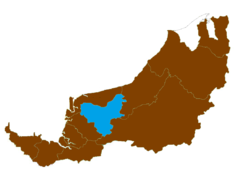Sibu Division
| Sibu | ||
|---|---|---|
|
||
 |
||
| Division Office location | Sibu | |
| Local area government(s) |
Sibu Municipal Council (SMC) Majlis Daerah Kanowit (MDK) Sibu Rural District Council (SRDC) |
|
| Area | ||
| • Total | 8,278.3 km2 (3,196.3 sq mi) | |
| Population (2010) | ||
| • Total | 293,514 | |
| • Density | 35/km2 (92/sq mi) | |
| Resident & Chairman | Sim Kok Kee | |
| License plate prefix | QS | |
Sibu Division is one of the twelve administrative divisions of Sarawak, Malaysia. It has a total area of 8,278.3 square kilometres, and is the third largest division after Kuching Division and Miri Division.
The population of Sibu Division (year 2000 census) was 257,300. Ethnically, the population was mostly Iban, Chinese, Malay, and Melanau.
Sibu Division consists of three districts: Sibu, Kanowit, and Selangau.
The economy is largely based on timber extraction from the extensive tropical rainforest. Processed wood products, rather than log export has been given priority by the government. Agriculture is relatively minor, with oil palm and pepper the main products. Tourism, particularly ecotourism, is a growing component of the economy.
The two major rivers in the Sibu Division are the Rajang River and the Igan River.
Before 1 June 1873, Sibu was known as "Maling", named after the winding portion, "Tanjung Maling", on the other side of Rejang River. Maling was a small village with a few small and simple shop houses consisted of atap roof and wooden walls and floors. Main population was Malay and Chinese was minority.
In 1841 "Sarawak" (the present Kuching - Sarawak Capital) was ruled by 'White Rajah', James Brooke. On 1 June 1873, the third division was created and the division was named after the native rambutan because the division had a lot of native rambutan known as "Buah Sibau" in Iban language.
In 1901 Mr. Wong Nai Siong led the first batch of Foochows from China to Sibu to open up the fertile lands of Sibu for cultivation, a massive opening up of Sibu. Therefore, it was a landmark year or a milestone in the history of the development of Sibu.
...
Wikipedia

